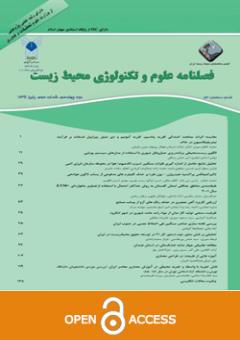Explaining the effective factors on users' satisfaction with the environmental quality of urban parks based on the variables of age and gender, Case study: urban parks in Babol
Subject Areas : Architecture and urbanismsoudabeh gholipour 1 * , Jamal-E-Din Mahdinejad 2
1 - PhD Researcher *(Corresponding Author)
2 - Professor, Shahid Rajaee Teacher Training University.
Keywords: Urban parks, Environmental quality, Demographic variables, satisfaction, users. ,
Abstract :
Background and Objective: The success of an urban space depends on its users’ satisfaction which results from fulfilling people's needs and their expectations. Users’ expectations and preferences information and their contributing can be effective in space planning design. The purpose of the research is to achieve effective components which improve the environmental quality of urban parks from the perspective of users with different personal characteristics. So, a question arises what the difference is between users’ preferences and their expectations from environmental quality of urban parks based on their gender and age.
Material and Methodology: To extract the questionnaire, based on the theorists’ approaches, studies in the field of environmental quality, and interviews with urban experts, the effective factors and criteria on the environmental quality of urban parks were extracted and questionnaire with a five-point Likert scale were designed to measure users’ satisfaction. Descriptive-survey method is used for the study. The population of the study was randomly selected from Shahid Shokri and Noshirvani park users in Babol city in different hours and days. After assessing the validity and reliability of the questionnaire, the relationship between variables was obtained using the Mann Whitney and Kruskal-Wallis tests through SPSS software.
Findings: The results indicate that there is no significant difference between gender and users’ satisfaction, however the age affects average satisfaction, so that peoples’ expectations with a higher average age are higher than other groups in their subset.
Discussion and Conclusion: The proposed indices and their prioritization can be considered in improving the performance of designers, executives and city managers in implementing appropriate models for the design of urban parks which are in line with the user's needs.
1. Maruthaveeran, S., 2017. Exploring the urban park use, preference and behaviours among the residents of Kuala Lumpur, Malaysia. Urban Forestry & Urban Greening, Vol. 25, pp. 85-93.
2. Chiesura, A., 2004. The role of urban parks for sustainable city. Landscape and Urban Planning, 68(1), pp.129-138.
3. Li, C.L., 2020. Quality of life: The perspective of urban park recreation in three Asian cities. Journal of Outdoor Recreation and Tourism, Vol. 29, pp. 1-10.
4. Hofmann, H., Westermann, J. R., Kowarik, I., van der Meer, E., 2012. Perceptions of parks and urban derelict land by landscape planners and residents. Urban Forestry & Urban Greening, 11, pp. 303–312.
5. Madureira, H.; Nunes, F.; Oliveira, J.V.; Madureira, T. (2018): Preferences for Urban Green Space Characteristics- A Comparative Study in Three Cities of Portuguese. Environments. 5 (2), pp.23.
6. Lansing, J. B., Marans, R.W., 1969. Evaluation of Neighborhood Quality. AIP Journal. Vol.11, pp. 195-199.
7. Barati, N, Kakavand, E., 2013. Comparative Evaluation of the Environmental Quality of Residential Place with an Emphasis on Citizens' Image (Case Study: Qazvin City), 18(3), pp. 25-32. (In Persian)
8. Kamp, I.V, Leidelmeijer, K., Marsman, G., Hollander, A.D., 2003. Urban Environmental Quality and Human Well-being towards a Conceptual Framework and Demarcation of Concepts, A Literature Study, Landscape and Urban Planning, 65, pp.5-18. (In Persian)
9. Pakzad, J., 2006. Theoretical foundations and urban design process. Publications of the Ministry of Housing and Urban Development. Vol 1, Tehran.
10. Golkar, K., 2001. Constituent components of urban design quality, Sofeh, 11(32), pp. 37-65. (In Persian)
11. Ghafourian, M., Hesari, E., 2016. Studying the background Variables and Factors Affecting the Satisfaction of the Residents in the Residential Environment, Journal of urban studies, 5(18), pp. 91-100. (In Persian)
12. Garcia-Ramon, M. D., Oritiz, A., Prats, M., 2004. Urban planning, gender and the use of the public space in a peripherals neighborhood of Barcelona, Cities, 21(3), pp. 215-223.
13. Ho, C., Sasidharan, V., Elmendorf, W., Willits, F.K., Graefe, A., Godbey, G., 2005. Gender and Ethnic Variations in Urban Park Preferences, Visitation, and Perceived Benefits. Journal of Leisure Research, 37(3), pp. 281-306.
14. 14- Mohammadi, J., Rakhshaninasab, M., 2011. Behavioral analysis of quantitative and qualitative factors affecting the attraction of citizens to urban parks in Isfahan Journal of Geographic space, 11(34), pp. 28-48. (In Persian)
15. Mak, B.K.L.; Jim, C.Y., 2019. Linking park users’ socio-demographic characteristics and visit-related preferences to improve urban parks. Cities. Vol. 92, pp.97–111.
16. Waltz, C. F., Bausell, B. R., 1981. Nursing research: design statistics and computer analysis. New York: Davis FA.
17. Reeves, D., Greed, C., 2003. Gender Equality and Plan Making: The Gender Mainstreaming Toolkit. Royal Town Planning Institute, London.
18. Habibi, M., Alipoor Shojaee, F., 2015. A Comparative Study between two Public Spaces, the Park of Behesht-e-Madaran, as a Specific Public Space for Women and the Park of Ab-o-Atash in Tehran, HONAR-HA-YE-ZIBA, MEMARI-SHAHRSAZI, 20(1), pp.17-30. (In Persian)
19. Madanipour, A., 2008. Urban space design: an approach to the socio-spatial process, Translared by Farhad Mortezaee, Vol.3. Tehran: Urban processing and planning company. (In Persian)
20. Perez, F.R., Fernandez, G.F.M., Rivera, E.P., Abuin, J. 2001. Ageing in place: Predictors of the residential satisfaction of elderly. Social indicators research, 54(2), pp. 173-208.
21. Jorgensen, A., Anthopoulou, A., 2007. Enjoyment and fear in urban woodlands – does age make a difference? Urban Forestry and Urban Greening, 6(4), pp.267–278.
22. Olesen, V. L., 2000. Feminisms and qualitative research at and into the millennium. In: Denzin, N. K., Lincoln, Y. S., (Ed.), Handbook of qualitative research, Sage Press, London, pp. 157-174.
23. Rush, L. M., 2012. An Autoethnography of Fuencarral 43: Women in Masculine Public Space. The Journal for Undergraduate Ethnography, 2(1), pp.1-13.
24. Wilbur, J., Chandler, P., Dancy, B., Choi, J., Plonczynski, D., 2002. Environmental, pol icy and cultural factors related to physical activities in urban, African American women. Women and Health, 36(2), pp.17–28.

